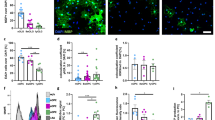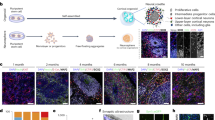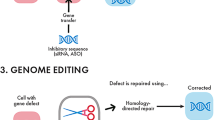Summary
The growth of strains of fibroblasts derived from patients with neurofibromatosis (NF) was compared with that of strains from appropriate controls in culture medium containing 1% or 15% fetal calf serum. The means of the ratios of final to initial cell numbers do not differ significantly between NF strains and control strains. Weakly significant differences are, however, obtained after conversion of the results to mean numbers of cell population doublings, the NF strains showing the higher numbers. The ratios of final to initial amounts of protein also differ significantly under both sets of growth conditions. High growth parameters occur significantly more frequently among our smaple of 11 NF strains than among our sample of 13 control strains. The possibility of the expression of the NF genotype(s) on the level of the cultured fibroblast-like cells and the possible causes of the large ranges of inter-and intra-individual variations of the results are discussed.
Similar content being viewed by others
References
Arlett CF, Lehman AR (1978) Human disorders showing increased sensitivity to the induction of genetic damage. Ann Rev Genet 12: 95–115
Dulbecco R (1970) Topoinhibition and serum requirement of transformed and untransformed cells. Nature (London) 227:802–806
Grove GL, Houghton BA, Cochran JW, Kress ED, Cristofalo VJ (1979) Hydrocortisone effects on cell proliferation: specificity of response among various cell types. Cell Biol Int Rep 1:147–155
Harper RA, Grove G (1979) Human skin fibroblasts derived from papillary and reticular dermis: differences in growth potential in vitro. Science 204:526–527
Hodges GM, Livingston DC Franks LM (1973) The localization of trypsin in cultured mammalian cells. J Cell Sci 12:887–902
Holley RN (1975) Control of growth of mammalian cells in culture. Nature (London) 258:487–490
Kanter WR, Eldrige R, Fabricant R, Allen JC, Koerber T (1980) Central neurofibromatosis with bilateral acoustic neuroma: genetic, clinical and biochemical distinctions from peripheral neurofibromatosis. Neurology 30:851–859
Kaufman M, Pinsky L, Straisfeld C, Shanfield B, Zihali B (1975) Qualitative differences in testosterone metabolism as an indication of cellular heterogeneity in fibroblast monolayers derived from human preputial skin. Exp Cell Res 96:31–36
Kopelovich LM, Pfeffer LM, Lipkin M (1976) Recent studies on the identification of proliferative abnormalities and of oncogenic potential of cutaneous cells in individuals at increased risk of colon cancer. Seminars Oncol 3:369–372
Kopelovich LM, Pfeffer LM, Bias M (1979) Growth characteristics of human fibroblasts in vitro. A simple experimental approach for the identification of hereditary adenomatosis of the colon and rectum. Cancer 43:218–223
Martin GM (1973) Human skin fibroblasts. In: Kruse PF Jr, Patterson MK (eds) Tissue culture: methods and application. Academic Press, New York, pp 39–44
McKeehan WL (1977) The effect of temperature during trypsin treatment on viability and multiplication potential of single normal human and chicken fibroblasts. Cell Biol Int Rep 1:335–343
Paterson MC, Smith PJ (1979) Ataxia telangiectasia. Ann Rev Genet 13:291–318
Pfeffer L, Lipkin M, Stutman O, Kopelovich L (1976) Growth abnormalities of cultured human skin fibroblasts derived from individuals with hereditary adenomatosis of the colon and rectum. J Cell Physiol 89:29–38
Pinsky L, Finkelberg R, Straisfeld L, Zihali B, Kaufman M, Hull G (1972) Testosterone metabolism by serially subcultured fibroblasts from genital and non-genital skin of individual human donors. Biochem Biophys Res Comm 46:364–369
Riccardi VM, Maragos VA (1980) Pathophysiology of neurofibromatosis. I. Resistance in vitro to 3-nitrotyrosine as an expression of the mutation. In Vitro 16:706–714
Rüdiger HW, Marxen J, Kohl F-V, Melderis H, Wickert P von (1979) Metabolism and formation of DNA adducts of benzo(a)pyrene in human diploid fibrolasts. Cancer Res 39:1083–1088
Ryan JM, Sharf BB, Cristofalo VJ (1975) The influence of culture medium volume on cell density and life span of human diploid fibroblasts. Exp Cell Res 91:389–392
Salk D, Bryant EM, Au K, Hoehn H, Martin GM (1981) Werner syndrome cultured skin fibroblasts; reduced growth potential, isolation of hybrid synkaryons, and prolonged survival of postreplicate cells. Hum Genet (in press)
Sanford KK (1974) Biologic manifestations of oncogenesis in vitro: a critique. J Natl Cancer Inst 53:1481–1485
Schneider EL, Fowlkes BJ (1976) Measurement of DNA content and cell volume in senescent human fibroblasts utilizing flow multiparameter single cell analysis. Exp Cell Res 98:298–302
Sergeyev AS (1975) On the mutation rate of neurofibromatosis. Humangenetik 28:129–138
Setlow RB (1978) Repair deficient human disorders and cancer. Nature (London) 271:713–717
Siemens HW (1926) Zum Studium der Abortivformen der Recklinghausen'schen Krankheit. Dermatol Ztr 46:168–176
Smets LA (1980) Cell transformation as a model for tumor induction and neoplastic growth. Biochem Biophys Acta 605:93–111
Stanbridge EJ, Wilkinson J (1978) Analysis of malignancy in human cells: malignant and transformed phenotypes are under seperate genetic control. Proc Natl Acad Sci (USA) 75:1466–1469
Stein GH (1979) T98G: An anchorage-independent human tumor cell line that exhibits stationary phase G1 arrest in vitro. J Cell Physiol 99:43–54
Webb T, Harding M (1977) Chromosome complement and SV 40 transformation of cells from patients susceptible to malignant disease. Br J Cancer 36:583–591
Zelkowitz M (1979) Slow growth of neurofibromatosis fibroblasts in tissue culture (Abstr). Neurology 29:569–569
Author information
Authors and Affiliations
Rights and permissions
About this article
Cite this article
Krone, W., Zörlein, S. & Mao, R. Cell culture studies on neurofibromatosis (von Recklinghausen). Hum Genet 58, 188–193 (1981). https://doi.org/10.1007/BF00278709
Received:
Revised:
Issue Date:
DOI: https://doi.org/10.1007/BF00278709




